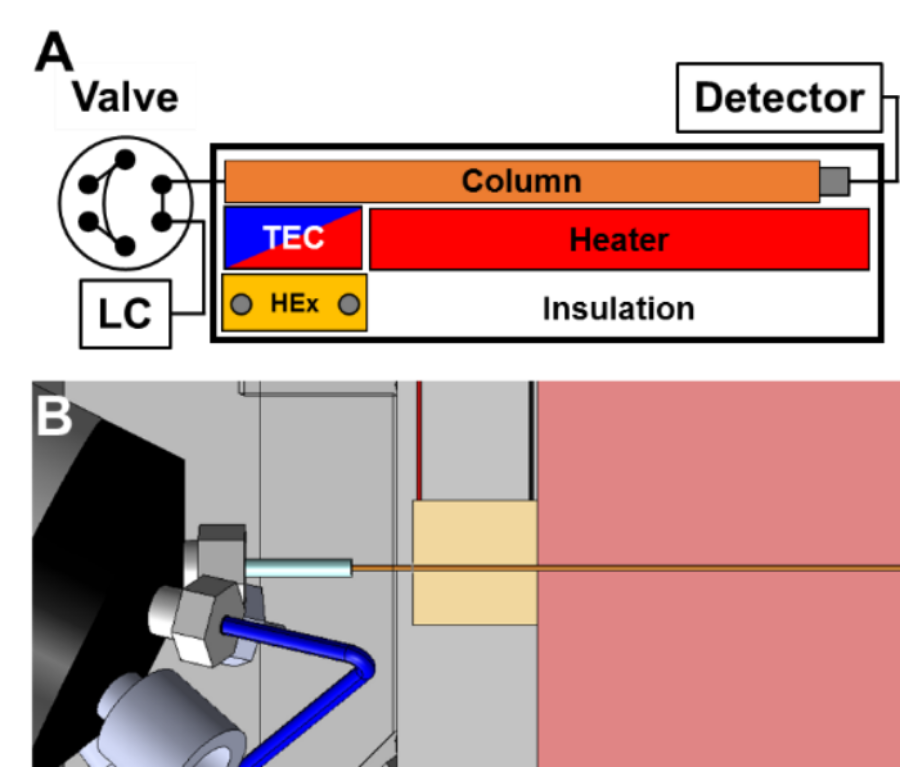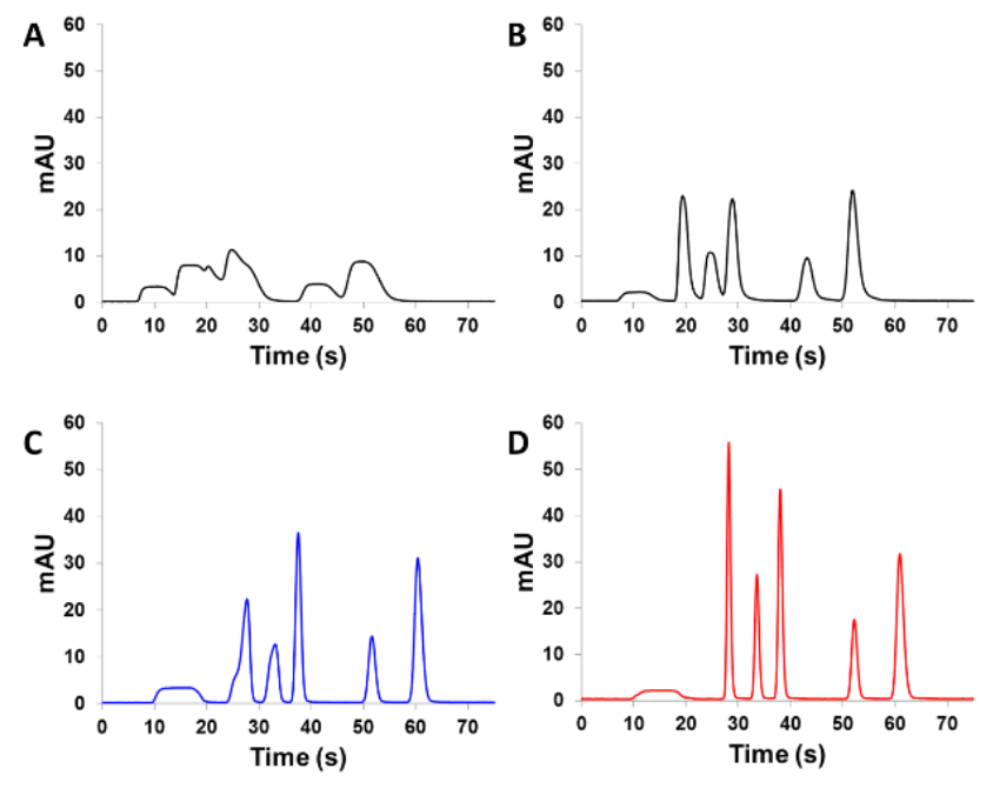Capillary liquid chromatography
Postcolumn reaction detection
Schematic of diffusion dependent microreactor (Beisler 2004)
Capillary liquid chromatography (cap-LC), characterized by columns with inner diameters < 500 micrometers, is particularly suited to the study of biological problems. Small column diameters decrease radial dilution and increase sensitivity, particularly for trace species such as peptides and neurotransmitters. However, small sample volumes also result in small chromatographic peaks which can make detection difficult. Our group has focused on improving the sensitivity of both optical and electrochemical detection of these species following separation by cap-LC. One way to improve cap-LC signal is to chemically modify analytes prior to detection, either pre- or post-separation. While precolumn modifications may alter analyte retention properties, postcolumn derivatization can result in large dead volumes that can be detrimental to small column separations. We have developed a diffusion-dependent microreactor for postcolumn derivatization with minimal contribution to band broadening (Beisler 2003, 2004). Using this device, the biuret reaction (Warner 1989, Chen 1995) has been used to bind copper (II) to non-electroactive peptides, allowing electrochemical detection of otherwise nonelectroactive species (Beisler 2004).
Chromatogram of neurotransmitters detected using PFET (Jung 2006)
Additionally, we have developed a technique known as photoluminescence following electron-transfer (PFET) in which a microreactor is used to mix cap-LC eluent with the oxidant tris(2, 2’-bypyridine)osmium (III) (Jung 2006). Upon mixing with an oxidizable analyte, the oxidant becomes reduced and photoluminesces following laser excitation (Jung 2006). This technique has been used for quantification of the neurotransmitters dopamine (DA) and serotonin (5HT) in rat brain dialysate with detection limits comparable to electrochemical or fluorescence detection and without issues caused by electrode fouling or pre-injection derivatization (Jung 2006).
Furthermore, we have developed the theoretical framework for optimizing post-column microreactor specifications for chromatographic conditions, including available pressure, column diameter, and the particle size of the packing material to minimize the effect of bandspreading specifically under high pressure, high temperature conditions as are often necessary for fast separations (Xu 2006, 2009). Using these calculations, we are able to develop microreactors for a variety of postcolumn derivatizations with minimal loss of sensitivity.
Active temperature control
To extract more quantitative chemical information from living systems we have set about addressing challenges to using capillary LC columns, namely volume overload, though the development of Active Temperature Control (ATC). ATC means to program temperature in time and space along the column’s long axis. We rely on the low thermal mass of fused silica capillary to make fast temperature changes chromatographically useful without suffering from the radial velocity inhomogeneities observed in larger diameter columns.
We have used ATC effectively to focus injected solutes by transiently cooling a short section of the column inlet, in a process we call temperature assisted solute focusing, TASF (Groskreutz 2014, 2015). During the injection of a sample of volume Vinj, the thermoelectric cooler (TEC, Peltier device) is held at a low temperature. This generally increases k' thus aiding in retaining the injected solutes in a narrow band at the head of the column. When the entire sample has been injected, the TEC's temperature is raised rapidly (~1000 K/minute), releasing the solutes for separation. The principle is similar to that of solvent focusing in which the k' during injection is dictated by the composition of the sample solvent itself (Groskreutz 2015), however it is more flexible, does not depend only on the sample composition, and can be used to augment solvent-based focusing.
The figures above show the apparatus (left) and a set of chromatograms (right).
Left:
Scheme for TASF system. A. A single thermoelectric element (TEC) heats/cools 1 cm of the column. The rest of the column is resistively heated. B. Realistic top view of the valve/column interface near the head of the column. Hex = heat exchanger.
Right:
Chromatogram for 1 μL Vinj (2 x the column liquid volume) with: A. no solvent focusing, B. with solvent focusing (φsample = 0.1), C. TASF only, D. with solvent focusing + TASF. Conditions: φ = 0.2 acetonitrile/10 mM phosphoric acid, T1 = 15 °C, T2 = 85 °C, F = 8.5 μL/min, λ = 254 nm. Solutes: uracil, methylparaben, acetophenone, ethylparaben, propiophenone, prophylparaben.



